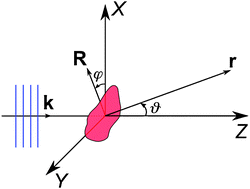An analytic model of the stereodynamics of rotationally inelastic molecular collisions
Abstract
We develop an analytic model of vector correlations in rotationally inelastic atom–diatom collisions and test it against the much examined Ar–NO (X2Π) system. Based on the Fraunhofer scattering of matter waves, the model furnishes complex scattering amplitudes needed to evaluate the polarization moments characterizing the quantum stereodynamics. The analytic polarization moments are found to be in an excellent agreement with experimental results and with close-coupling calculations available at thermal energies. The model reveals that the stereodynamics is governed by diffraction from the repulsive core of the Ar–NO potential, which can be characterized by a single Legendre moment.


 Please wait while we load your content...
Please wait while we load your content...